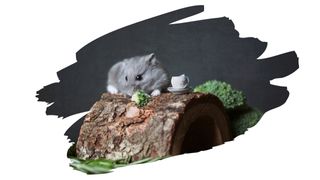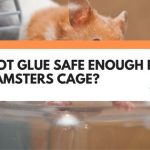MDF is a very affordable wood composite material. And, thanks to its affordability, this material is widely used for furniture, flooring, and even soundproofing walls.
However, MDF is far less safe than solid untreated natural wood. Instead, made up of compressed wood fibers and glues, this material contains a lot of chemicals.
But, if it has been properly sealed, will it still pose a risk to your hamsters health?
Well, in this post you will learn about what really goes into the manufacture of MDF boards. You’ll also find out why some of the chemicals used to make MDF can be dangerous.
And keep reading to find out the safest type of wood you can have around your pet hamster.

This post may contain affiliate links to products that we receive a commission for (at no additional cost to you). Learn more here.
What Is MDF Really Made Out Of?
MDF is far from a natural material. Instead, it is an engineered wood made up of wood shavings, all held together by chemical glue.
Those wood shavings are densely packed, making MDF (Medium Density Fiberboard) stronger than other types of fiberboard (such as Particle Board).
Is It Harmful? I’ve Read Some Scary Things About MDF Dust…
MDF sawdust is dangerous due to the glue inside of it.
You see, the dangerous part of MDF hides inside the glues often used to make it. MDF is manufactured using a glue that contains Urea-Formaldehyde (UF). And Urea-Formaldehyde contains Formaldehyde resins.
Formaldehyde is nothing to sniff at…literally! It can burn our skin, and it is poisonous if it’s ingested. But, it is at its most lethal when it is inhaled.
However, MDF isn’t the only type of manufactured wood to contain formaldehyde-resin glues. Plywood, for example, also contains similarly dangerous types of chemical glues in it too.
Related Post: Is Plywood A Safe Material For A Hamsters Cage?
Nevertheless, what sets MDF apart is the amount of formaldehyde in it.
Since this material is so dense, it requires a lot more glue to hold it together. And if there is a lot more Urea-Formaldehyde in MDF, then there’ll be more formaldehyde in it over all.
This is why MDF sawdust, (containing those Urea-Formaldehyde glue particles), is so scary to have around.
On top of that, formaldehyde-resin glues release fumes as they dry (kind of like solvent paints). This is called off-gassing, and it happens when those gasses — aka VOC’s (Volatile Organic Compounds) — waft into the air.
What’s more, even after the glue dries, that glue can continue to release fumes into the air for a good couple years. And those formaldehyde fumes are just as dangerous as MDF sawdust (if inhaled).
Do I Need To Be Worried About Having MDF Around My Hamster?
Yes, but not for the reasons you might think.
First off, provided MDF has stopped off-gassing, (and is properly sealed), it is not dangerous to be around.
Generally, MDF manufacturers will allow MDF boards to air out and dry for months. So, technically, MDF should have stopped off-gassing before you purchase it.
But, the problem with having MDF around chew-happy pets, is that ingesting formaldehyde glues is almost as dangerous as inhaling it. Both to ourselves and to our hamsters.
And if your pet were to chew through the seal coating MDF, then ingesting that glue will poison your hamster.
Are There Any Formaldehyde-Free MDF Boards Out There?
There is. These specially made (and very expensive) MDF materials are known as Zero-Added Formaldehyde MDF.
They release next to no VOC’s into the air. Nevertheless, they too, contain chemical glues that are not safe for hamsters to ingest, regardless.
So Does That Mean MDF Is Not Safe For Hamsters?
Honestly? No it is not. Far from it.
The chances of your hamster chewing into MDF is too great a risk to take. So you should not use MDF to either make your hamsters home, or anything inside it.
When it comes to pet safety, it’s best to err in the side of caution.
And What Type Of Wood Is Safe For Hamsters?
Stick to using natural kiln-dried solid wood. And avoid using any wood that has been chemically treated and/or sealed.
On top of that, only use lumber that comes from hamster-safe tree species, such as Apple wood.
Related Post: Want To Use Apple Wood For Woodworking? 3 Things To Know
Also, it is worth mentioning that you should avoid any wood type that is saturated with tree sap/pitch.
Timbers, such as Fir and Pine, contain a high amount of tree sap. Tree sap is a natural resinous substance that trees secrete. But, you don’t want your hamster ingesting it.
Having said that, if wood has been kiln dried, most tree sap will have evaporated away. But, you’re still better off steering clear of these wood types, all the same.
And What Is Kiln Dried Wood Exactly?
‘Kiln dried’ is the term given to wood that has been seasoned using a heat-treatment involving a kiln oven.
Regular air-dried seasoned wood can take 6-12 months to dry out, after they’ve been logged. But, kiln drying cuts that waiting time down to a matter of days.
Kiln drying is also a great way to get rid of any hidden bugs that like to live in wood.
Related Post: Kiln Dried Vs Air Dried Wood: Which Type Of Seasoned Lumber Is Right For Your Furniture?
To Wrap Up, Here Are The 3 Key Takeaways From This Post…
- 1). MDF is a manufactured wood made up of wood shavings and glue. The glue used to manufacture MDF contains formaldehyde.
- 2). Formaldehyde is a very dangerous substance. It would pose a high risk to your hamsters health, if they happened to chew into MDF.
- 3). Only use hamster-safe natural solid wood, such as Apple wood, in your hamsters home. It should also be untreated, and ideally kiln dried too.
References:
Creating the right home for your hamster | RSPCA.org.uk
Our MDF furniture brought toxic fumes into our home | The Guardian



